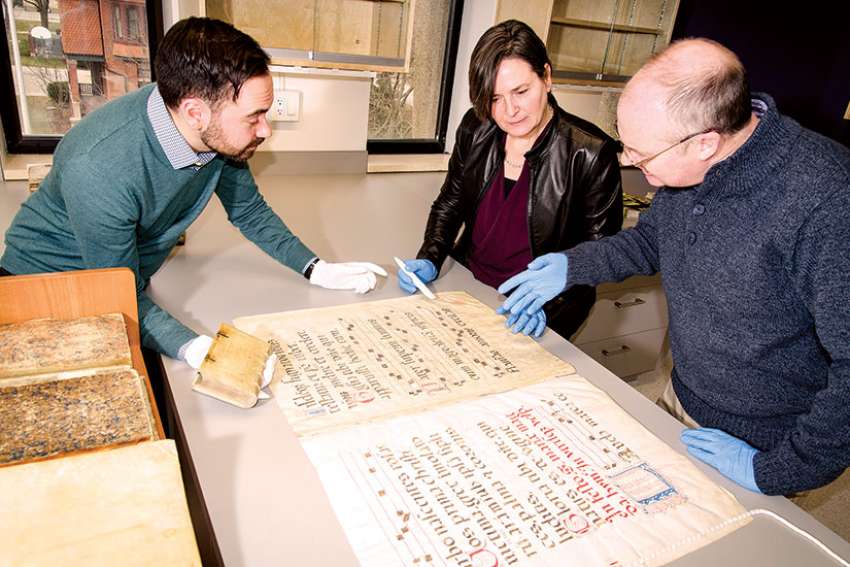And they are just two examples of valuable works being preserved in a new studio at the Kelly Library on the campus of the University of St. Michael’s College.
“We are in a position right now where a lot of our materials need conservation work and accordingly are in fragile condition,” said James Roussain, an archivist at St. Michael’s. “They cannot be used by our scholars and researchers.”
A restoration team is dealing with a large inventory of literature that, for example, holds a collection of G.K Chesterton’s works, including a personally inscribed selection of Fr. Brown stories given by Chesterton to Msgr. John O’Connor, the inspiration for the popular series.
There are also collections of manuscripts and personal papers from the likes of Canadian author Sheila Watson, writer and theologian Henri Nouwen and Irish nationalist politician Patrick O’Neill.
But conservation does not mean restoration, said Roussain.
“In our tradition it is not to make the item look brand new, but rather just to make it stable enough so that it can be handled,” he said. “One of the most challenging things would be to do the repair but to make it look as if nothing has happened. You do that in a manner that respects the state that it is in but that allows it again to be used.”
That means evaluating each item and striking a balance between the significance of the content and the condition of the book.
“It’s a judgment call with aesthetics,” he said, “(of) how much do you want to compromise the original look?”
Although no two cases are the same, Roussain said it is not uncommon to spend 30 to 40 hours to give one piece a basic treatment.
“It is extremely slow, tedious work that has to be done with a careful eye to detail,” he said. “So it is very costly work and that is where the appraisal comes in. Is this piece worth the conservation?”
About a dozen conservators can comfortably work in the studio, which is equipped with movable work stations, running water, two exhaust systems and a hood and breathing apparatus for use when chemicals are involved.
The original library at St. Michael’s was stocked primarily with books that the Basilian fathers brought from Europe, said Roussain.
“We’re hoping to make those books available for use in the next five to 10 years,” he said.
Sheril Hook, the chief librarian, said doing conservation work is more than a job; it’s a duty.
“As a library with these items we have to be concerned about their care,” she said. “It is one thing to collect them, and a lot of people have a collection which is great, but what do you do when they start falling apart?
“This is a new space for us so we are just starting to go down the road of properly conserving.”
Prior to a “soft opening” of the studio on Feb. 28, all conservation work was done in a small one-person office.
“We’ve just never had a space like this before,” she said. “People just made do with whatever they had at their disposal.”
In addition to books and manuscripts, the library also holds the school’s archival records, including early administrative records, copies of student publications as well as a French-English dictionary from the mid-1800s.
How a book was constructed is another significant factor weighed when determining which books should be saved.
“Nowadays, every copy of a book that is produced is the same, but 500 years ago every copy of a book was different,” said said Noel McFerran, theology and rare books librarian. “It is very impressive when you look at a book from the 1500s and you consider the amount of work that went in to the item.”
The significance of these differences is explored by students enrolled in the Book and Media Studies Program. The program explores not only the content of books but also their physical construction, said Roussain.
Students also study the significance of different types of ink, of printing on animal skins and various styles of binding and clasps.
“If you were to simply digitize and scrap the originals,” Russian said, “you would lose that example and lose that knowledge of how books were constructed.”
With the new studio, Roussain anticipates an increasing number of students spending time in conservation study.
“We envision this space as also being used for education and to bring in student groups to a hands-on facility where students can learn,” he said. “Having students come in to see pictures of books is one thing but to actually have an opportunity to hold the item and feel the binding and touch it, to just feel the physical experience of it, that is quite different. That creates a memory in students.”
But first the texts must be preserved.
“That is one of the major driving points here,” he said. “Being able to hold an item from the past and say this is physical, this existed with people who existed before me, is a link to the past.”


